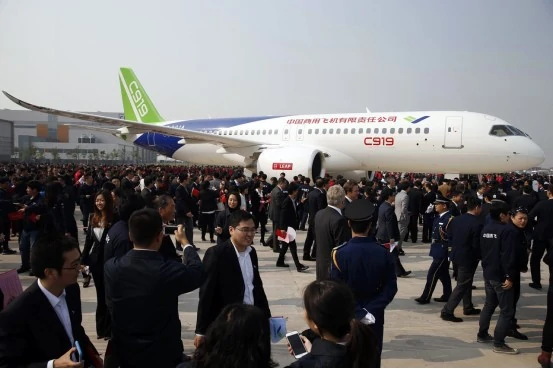Mark Xu reports on the maiden flight of China’s first passenger plane
In recent years, China-Britain Business Council has been monitoring the aerospace supply chain, from research and design to testing, manufacturing, repair and maintenance. It is a key sector under China’s Made-in-China (MIC) 2025 initiative (see CBBC’s report on MIC2025 HERE).
China’s aerospace and aviation industry has developed rapidly over the past decade, and May 5 2017 marked the maiden flight for the COMAC-manufactured C919, the first-ever passenger jet designed and built by the country. Following the introduction of the project in China’s 11th five-year plan back in 2006, the COMAC C919 was scheduled for its maiden flight back in 2014. However, due to a combination of delayed R&D progress and strict safety regulations, the maiden flight fell three years behind schedule.
The letter “C” in the model number not only represents the first letter of COMAC and China, but is also intended to make the point that this new jet will compete with the Airbus A320neo and the Boeing 737 MAX and create a new “ABC” market presence. COMAC is yet to release the official price tag of the jet, but a report by China National Radio in 2016 predicted that the C919 will likely be priced at around $50 million, up to 30% cheaper than its Boeing or Airbus competitors.
As of today, the C919 has received orders of more than 570 aircraft from 23 clients ranging from airline operators such as Air China and China Eastern, to asset management and leasing companies such as GECAS (GE Capital Aviation Services) and China Development Bank Leasing. The first commercial flight of the C919 is yet to be announced, but based on the fact that the Boeing Dreamliner took two years from maiden flight to commercial flight, we can expect a similar timeframe for the C919.
COMAC also plans to introduce a twin-aisle wide-body plane, the C929, in cooperation with Russia’s United Aircraft Corporation, and speculation is mounting that China will create a new aero engine entity to produce the more powerful jets required for the larger civil aircraft.
There has been widespread debate about exactly how much of the C919’s technology and components are really China-made. Although over 300 local Chinese suppliers were involved in the supply chain, most of these are considered level 2 and 3 suppliers. The top level of suppliers included 17 global aerospace companies such as Honeywell, which provided the aircraft’s hardware and avionics systems and UTC Aerospace, which provided various systems for the electrics, emergency power, fire protection and pilot control.
Although over 300 local Chinese suppliers were involved in the supply chain, most of these are considered level 2 and 3 suppliers. The top level of suppliers included 17 global aerospace companies such as Honeywell
Compared to the Airbus and Boeing jets, the performance, reliability and market competitiveness of the C919 still has a long way to go. The development of the Chinese civil aviation industry will be a long process and perhaps only after another few generations of aviation progress can it really compete on an equal footing with Airbus and Boeing.
Regarding the aviation industry growth potential as a whole, according to Airbus’ Global Market Forecast in 2015, within the next 20 years, passenger air traffic will grow at 4.6 percent annually with a demand for around 32,600 new passenger and freighter aircraft. The Chinese market will play a major role in contributing a market demand of 6,000 new aircraft (18% of total market demand) worth a combined value of $945 billion. Within the forecast, it also predicts that China will become the leading country for passenger air traffic within ten years, with its growing domestic air traffic and over 200 new airports either planned for or already under construction
CBBC continues to monitor trends and developments in the aerospace sector and looks forward to being involved in events such as the Farnborough International Air Show, The Airport and Air Traffic Expo and the British Aviation Group (BAG) Mission.
For more information on the aerospace industry please contact the author, Mark Xu, sector lead for advanced manufacturing and transport at the China-Britain Business Council: mark.xu@cbbc.org.cn.


